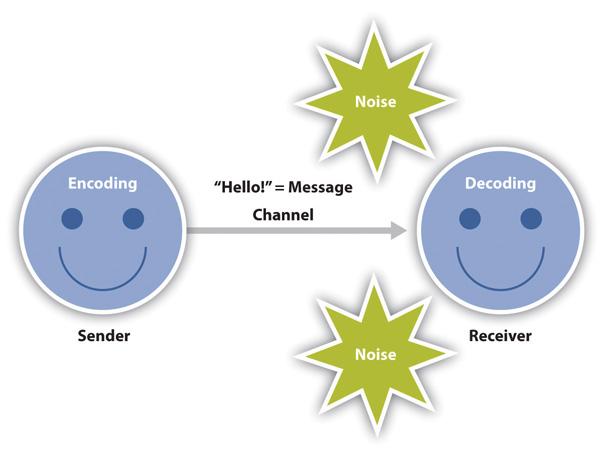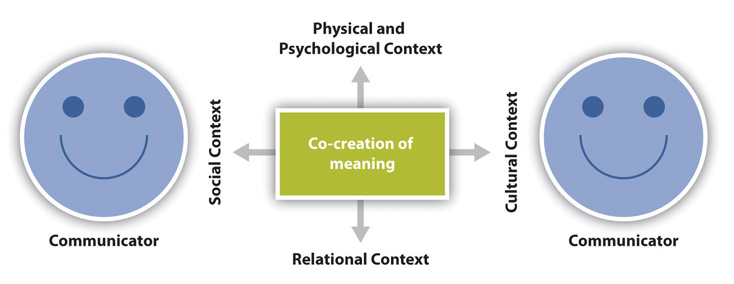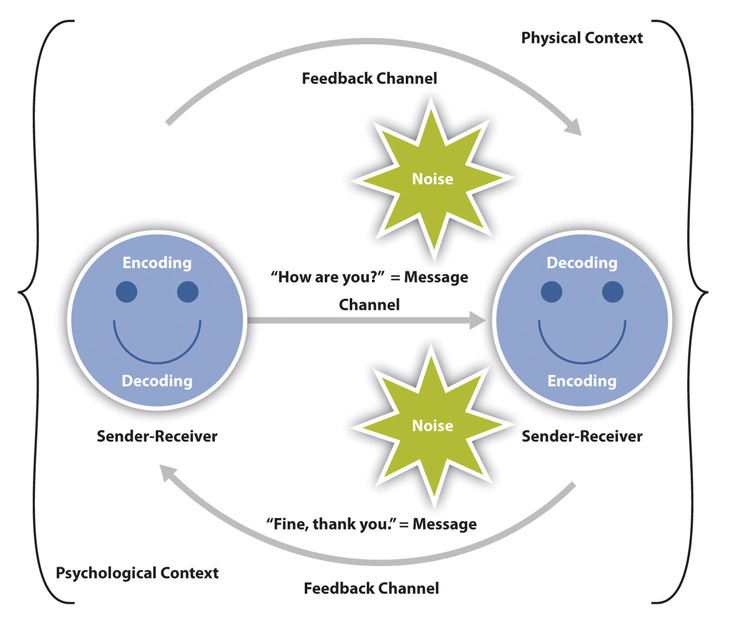9 Communication models
Melissa Ashman
Communication is a complex process, and it is difficult to determine where or with whom a communication encounter starts and ends. It can sometimes be helpful to consider different communication models. Below are some questions to help guide you through this chapter.
Questions for reflection
- Why do models (of anything) matter in the real world?
- What value do communication models have?
- What communication models do you know about already?
- How can learning about communication models be helpful to you?
Models of communication simplify the process by providing a visual representation of the various aspects of a communication encounter. Some models explain communication in more detail than others, but even the most complex model still doesn’t recreate what we experience in even a moment of a communication encounter. Models still serve a valuable purpose for students of communication because they allow us to see specific concepts and steps within the process of communication, define communication, and apply communication concepts. When you become aware of how communication functions, you can think more deliberately through your communication encounters, which can help you better prepare for future communication and learn from your previous communication. The three models of communication we will discuss are the transmission, interaction, and transaction models.
Although these models of communication differ, they contain some common elements. The first two models we will discuss, the transmission model and the interaction model, include the following parts: participants, messages, encoding, decoding, and channels. In communication models, the participants are the senders and/or receivers of messages in a communication encounter. The message is the verbal or nonverbal content being conveyed from sender to receiver. For example, when you say “Hello!” to your friend, you are sending a message of greeting that will be received by your friend.
The internal cognitive process that allows participants to send, receive, and understand messages is the encoding and decoding process. Encoding is the process of turning thoughts into communication. As we will learn later, the level of conscious thought that goes into encoding messages varies. Decoding is the process of turning communication into thoughts. For example, you may realize you’re hungry and encode the following message to send to your roommate: “I’m hungry. Do you want to get pizza tonight?” As your roommate receives the message, they decode your communication and turn it back into thoughts in order to make meaning out of it. Of course, we don’t just communicate verbally—we have various options, or channels for communication. Encoded messages are sent through a channel, or a sensory route on which a message travels, to the receiver for decoding. While communication can be sent and received using any sensory route (sight, smell, touch, taste, or sound), most communication occurs through visual (sight) and/or auditory (sound) channels. If your roommate has headphones on and is engrossed in a video game, you may need to get their attention by waving your hands before you can ask them about dinner.
Linear model of communication
The linear or transmission model of communication, as shown in Figure 2.2.1, describes communication as a linear, one-way process in which a sender intentionally transmits a message to a receiver (Ellis & McClintock, 1990). This model focuses on the sender and message within a communication encounter. Although the receiver is included in the model, this role is viewed as more of a target or end point rather than part of an ongoing process. We are left to presume that the receiver either successfully receives and understands the message or does not. The scholars who designed this model extended on a linear model proposed by Aristotle centuries before that included a speaker, message, and hearer. They were also influenced by the advent and spread of new communication technologies of the time such as telegraphy and radio, and you can probably see these technical influences within the model (Shannon & Weaver, 1949). Think of how a radio message is sent from a person in the radio studio to you listening in your car. The sender is the radio announcer who encodes a verbal message that is transmitted by a radio tower through electromagnetic waves (the channel) and eventually reaches your (the receiver’s) ears via an antenna and speakers in order to be decoded. The radio announcer doesn’t really know if you receive their message or not, but if the equipment is working and the channel is free of static, then there is a good chance that the message was successfully received.

Figure 2.2.1 The linear model of communication
Although the transmission model may seem simple or even underdeveloped to us today, the creation of this model allowed scholars to examine the communication process in new ways, which eventually led to more complex models and theories of communication.
Interactive model of communication
The interactive or interaction model of communication, as shown in Figure 2.2.2, describes communication as a process in which participants alternate positions as sender and receiver and generate meaning by sending messages and receiving feedback within physical and psychological contexts (Schramm, 1997). Rather than illustrating communication as a linear, one-way process, the interactive model incorporates feedback, which makes communication a more interactive, two-way process. Feedback includes messages sent in response to other messages. For example, your instructor may respond to a point you raise during class discussion or you may point to the sofa when your roommate asks you where the remote control is. The inclusion of a feedback loop also leads to a more complex understanding of the roles of participants in a communication encounter. Rather than having one sender, one message, and one receiver, this model has two sender-receivers who exchange messages. Each participant alternates roles as sender and receiver in order to keep a communication encounter going. Although this seems like a perceptible and deliberate process, we alternate between the roles of sender and receiver very quickly and often without conscious thought.
The interactive model is also less message focused and more interaction focused. While the linear model focused on how a message was transmitted and whether or not it was received, the interactive model is more concerned with the communication process itself. In fact, this model acknowledges that there are so many messages being sent at one time that many of them may not even be received. Some messages are also unintentionally sent. Therefore, communication isn’t judged effective or ineffective in this model based on whether or not a single message was successfully transmitted and received.
Figure 2.2.2 The interactive model of communication
The interactive model takes physical and psychological context into account. Physical context includes the environmental factors in a communication encounter. The size, layout, temperature, and lighting of a space influence our communication. Imagine the different physical contexts in which job interviews take place and how that may affect your communication. I have had job interviews over the phone, crowded around a table with eight interviewers, and sitting with few people around an extra large conference table. I’ve also been walked around an office to unexpectedly interview one-on-one, in succession, with multiple members of a search committee over a period of three hours. Whether it’s the size of the room or other environmental factors, it’s important to consider the role that physical context plays in our communication. Psychological context includes the mental and emotional factors in a communication encounter. Stress, anxiety, and emotions are just some examples of psychological influences that can affect our communication. Seemingly positive psychological states, like experiencing the emotion of love, can also affect communication. Feedback and context help make the interaction model a more useful illustration of the communication process, but the transaction model views communication as a powerful tool that shapes our realities beyond individual communication encounters.
Transaction model of communication
As the study of communication progressed, models expanded to account for more of the communication process. Many scholars view communication as more than a process that is used to carry on conversations and convey meaning. We don’t send messages like computers, and we don’t neatly alternate between the roles of sender and receiver as an interaction unfolds. We also can’t consciously decide to stop communicating because communication is more than sending and receiving messages. The transaction model differs from the transmission and interaction models in significant ways, including the conceptualization of communication, the role of sender and receiver, and the role of context (Barnlund, 1970).
The transaction model of communication describes communication as a process in which communicators generate social realities within social, relational, and cultural contexts. In this model, which is shown in Figure 2.2.3, we don’t just communicate to exchange messages; we communicate to create relationships, form intercultural alliances, shape our self-concepts, and engage with others in dialogue to create communities.
The roles of sender and receiver in the transaction model of communication differ significantly from the other models. Instead of labeling participants as senders and receivers, the people in a communication encounter are referred to as communicators. Unlike the interactive model, which suggests that participants alternate positions as sender and receiver, the transaction model suggests that we are simultaneously senders and receivers. This is an important addition to the model because it allows us to understand how we are able to adapt our communication—for example, a verbal message—in the middle of sending it based on the communication we are simultaneously receiving from our communication partner.

Figure 2.2.3 The transaction model of communication
The transaction model also includes a more complex understanding of context. The interaction model portrays context as physical and psychological influences that enhance or impede communication. While these contexts are important, they focus on message transmission and reception. Since the transaction model of communication views communication as a force that shapes our realities before and after specific interactions occur, it must account for contextual influences outside of a single interaction. To do this, the transaction model considers how social, relational, and cultural contexts frame and influence our communication encounters.
Social context refers to the stated rules or unstated norms that guide communication. Norms are social conventions that we pick up on through observation, practice, and trial and error. We may not even know we are breaking a social norm until we notice people looking at us strangely or someone corrects or teases us. Relational context includes the previous interpersonal history and type of relationship we have with a person. We communicate differently with someone we just met versus someone we’ve known for a long time. Initial interactions with people tend to be more highly scripted and governed by established norms and rules, but when we have an established relational context, we may be able to bend or break social norms and rules more easily. Cultural context includes various aspects of identities such as race, gender, nationality, ethnicity, sexual orientation, class, and ability. We all have multiple cultural identities that influence our communication. Some people, especially those with identities that have been historically marginalized, are regularly aware of how their cultural identities influence their communication and influence how others communicate with them. Conversely, people with identities that are dominant or in the majority may rarely, if ever, think about the role their cultural identities play in their communication. Cultural context is influenced by numerous aspects of our identities and is not limited to race or ethnicity.
References
Barnlund, D. C. (1970). A transactional model of communication in K.K. Sereno and C.D. Mortenson (Eds.), Foundations of communication theory (pp. 83-92). New York, NY: Harper and Row.
Ellis, R. and McClintock, A. (1990). You take my meaning: Theory into practice in human communication. London: Edward Arnold.
Schramm, W. (1997). The beginnings of communication study in America. Thousand Oaks, CA: Sage.
Shannon, C. and Weaver, W. (1949). The mathematical theory of communication. Urbana, IL: University of Illinois Press.
Attribution
This chapter contains material taken from Chapter 1.2 “The communication process” in Communication in the real world: An introduction to communication studies and is used under a CC-BY-NC-SA 4.0 International license.


